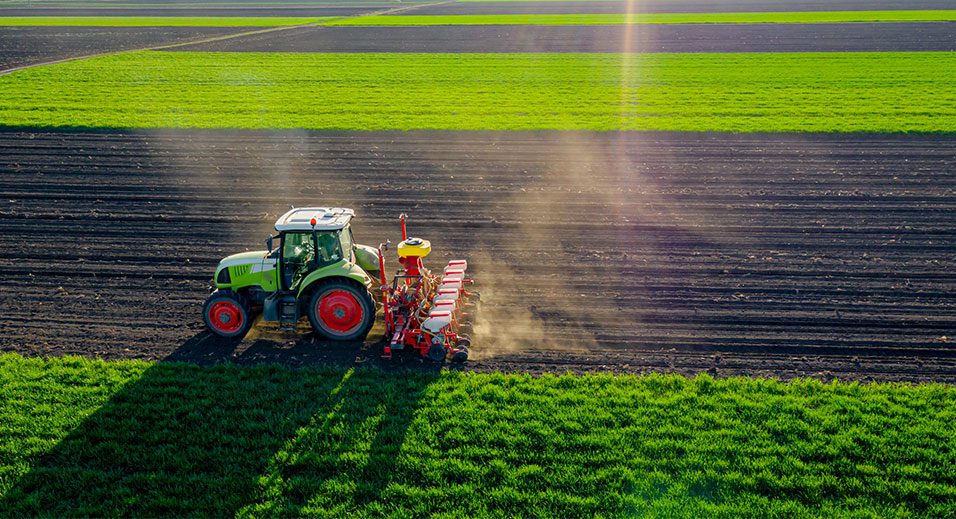Let’s celebrate our planet! Discover how regenerative agriculture creates sustainable farming practices and supports our commitment to be environmentally responsible.
By Mauricio Alanis, Director of Sustainability Strategy & Regenerative Agriculture Lead
When you think of climate change, you might consider carbon dioxide (CO2) to be one of the main culprits behind this pressing issue of our time. What you may not know is that carbon is not inherently bad! It’s essential for life on Earth and is actually the basis of all living things, from the smallest microbe to the largest whale. The problem is not that we have carbon, but that we have moved it from the land and sea and into the atmosphere, creating a powerful imbalance that contributes to global warming and climate change overall.
Through our resource-heavy industrialization, we have disrupted the natural carbon cycle and put too much of it in the wrong place: the atmosphere. But what if we could restore the balance and put carbon back where it belongs: into the soil, plants, and animals while enhancing the natural ecosystems that sustain us all? That’s the idea behind regenerative agriculture, an innovative (albeit, old!) approach to farming that can help heal the planet while feeding the world.
The big question at hand is, ‘where do we put this excess carbon to get the cycle back in balance?’ Fortunately, the answer is literally right under our feet! We can put it back into the soil. Unlike carbon in the atmosphere, carbon in the ground makes healthy, nutrient-rich soil that produces healthier crops.
We must make a change — now. Regenerative agriculture is one step to restoring the detrimental effects of climate change.
The principles of regenerative agriculture
Regenerative agriculture is a hot topic in the agri-food industry, and for good reason. It’s a set of farming principles and practices that regenerate the land, capture carbon from the atmosphere and store it in the soil, increase biodiversity, improve soil health, boost farmer profitability and productivity, and enhance landscape resilience. It aims to create a positive feedback loop between the soil and the atmosphere, where carbon is captured from the air and stored in the soil, rather than released as a greenhouse gas. This can help mitigate climate change and improve soil health, which in turn supports more nutritious and diverse crops and livestock.
Regenerative agriculture also benefits the farmers, who can reduce their input costs, increase their income, and help adapt their fields to changing weather conditions. Moreover, regenerative agriculture benefits the consumers, who can know that they are supporting more resilient and sustainable methods of caring for our land and feeding the world.
Core principles of regenerative agriculture include understanding the context of farm operations, minimizing soil disturbance, diversifying crops, and maintaining soil coverage and living roots year-round. When compared with conventional agriculture, a key difference is that regenerative agriculture can help slow climate change by enhancing stored carbon on agricultural lands. Storing, or sequestering, carbon in soil as organic matter, perennial vegetation, and in trees reduces carbon dioxide amounts in the atmosphere.
Our long-term commitment to environmental sustainability
As part of our vision to be the most sustainable protein company on Earth, we have set ambitious goals. We’ve committed to reduce absolute scope 1 and 2 GHG emissions (from our operations) by 30% by 2030, and reduce scope 3 GHG emissions (from our supply chain) by 30% per tonne of product produced by 2030. In fact, the largest source of emissions in our supply chain is from the animal protein value chain of meat we source.
To achieve these goals, we are working with our suppliers, especially the farmers who produce the feed for our animals, to adopt and implement regenerative agriculture practices.
To verify this process, we aim to be credible, verifiable, and scalable in our regenerative agriculture projects. To achieve this, we follow different standards and protocols that model, measure, verify, and monitor the impacts of our interventions on the land. We also seek independent verification from third parties to validate our claims and ensure that we’re getting our practices right.
We’ve partnered with Nutrien, a Canadian agriculture company, to educate and incentivize farmers to adopt regenerative practices. These practices can help improve water quality and retention, reduce soil erosion and nutrient runoff, enhance soil fertility and crop yields, and create more resilient and diverse ecosystems.
In 2023, we also became a founding member of the Canadian Alliance for Net-Zero Agri-Food (CANZA), a national, industry-led, multi-stakeholder alliance that fosters collaboration and innovation towards net-zero emissions in the agri-food sector.
Goals for GHG reduction and regenerative farming practices
By supporting regenerative agriculture, we are contributing to a more sustainable and resilient food system, while also delivering delicious and nutritious products to our consumers.
We recognize that regenerative agriculture is not a one-size-fits-all solution, and that it requires a long-term commitment and a systemic change in the way we produce and consume food. We also acknowledge that there are some barriers and risks that may hinder the adoption of regenerative agriculture practices, such as the lack of awareness, knowledge, and skills, the upfront costs and investments, the market and policy uncertainties, and the cultural and behavioral factors.
However, we also see many opportunities and benefits that can outweigh the challenges, such as the potential to reduce our emissions, improve our soil’s health and supply chain’s resilience, increase our biodiversity, potentially enhance our product quality and nutritional benefits, strengthen consumer loyalty, and create a competitive advantage in the market. We are confident that by working together with our stakeholders, we can overcome the obstacles and seize the opportunities that regenerative agriculture offers.
We encourage our Team Members and our consumers to learn more and get involved in regenerative agriculture, as we believe that it is a collective effort and a shared responsibility to create a more sustainable and resilient food system.
Join us on our journey this Earth Day and every day! Click here to learn more about sustainability at Maple Leaf Foods.


